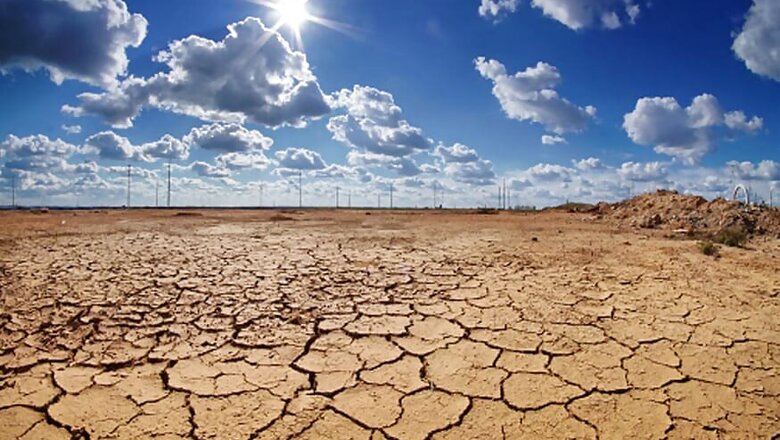
views
Mumbai returned to a normal life after heavy rain last Sunday and Monday, while Delhi and its surrounding areas received little showers on Friday. However, a full monsoon rain is still awaited in many parts of country, specially in north and central India.
This is a monsoon deficit year in India. Delhi has witnessed around 90% less rainfall in the last five weeks. A large part of country, including Uttar Pradesh, Madhya Pradesh, Punjab, Rajasthan, Bihar and parts of Maharashtra, has not seen monsoon yet.
Normally, the month of June receives around 17% of the total rainfall of monsoon season between June and September, but this year the rain deficit in June was recorded at more than 50%. Obviously, farmers are worried and are bound to suffer losses even if the deficit is covered in the coming months.
India has seen abnormally hot and prolonged dry weather this year, causing severe heatwave across the country. Environment journal Down to Earth reported that within the first 100 days, starting March 1 this year, the country witnessed more than 70 heatwave spells in 22 states. In Bihar alone, more than 200 people died, and deaths were also reported from southern states like Tamil Nadu.
According to the India Meteorological Department (IMD), heatwave conditions were prevalent in parts of Punjab, Rajasthan, Delhi and Uttar Pradesh on Monday and Tuesday, where the temperature was recorded at 5.1 degree Celsius above normal. Data provided by IMD says several other parts of the country witnessed temperature “appreciably above normal” which means temperature more than 3 to 5 degrees higher than normal.
Scientists say such killer heatwaves should worry countries like India that will bear the maximum brunt of climate change effects in coming years. According to a research in Science Advances, people in densely populated agricultural regions in South Asia are going to suffer more heatwaves than anywhere else.
This research paper prepared by scientists, including experts at Massachusetts Institute of Technology (MIT), says, “The risk of human illness and mortality increases in hot and humid weather associated with heat waves… because normal human body temperature is maintained within a very narrow limit of ±1 degree Celsius, disruption of the body’s ability to regulate temperature can immediately impair physical and cognitive functions.”
The report explains how countries like India, Pakistan and Bangladesh are most vulnerable. “The geographical locations of the most extreme projected heatwaves in the Indus and Ganges river valleys coincide largely with locations of highly vulnerable human populations in terms of population density, gross domestic product (GDP) per capita, and agricultural intensity. Agriculture workers in these regions spend significant time working outdoor during the seasons with the highest severity,” it says.
Empirical data supports the research as the number of heatwave spells has sharply increased in last few years. According to data available on the website of Ministry of Statistics and Programme Implementation, between 2010 and 2016, the country witnessed a total of 178 heatwave bouts, but in 2017 alone India suffered 524 heatwave spells.
However, last year, the number came down to 484. Worst-affected states were Rajasthan, Madhya Pradesh, Maharashtra and Andhra Pradesh where a total of 297 heatwave spells were experienced in 2017. The figure for these states stood at 331 in 2018.
Water scarcity along with increasing number of heatwave spells has surfaced as a big threat to life in recent times. Ground water level has dropped more than 54% this year. According to the Central Water Commission, there was less than 20% water in the 90 reservoirs in June. Some of them, like in Chennai, had almost dried up.
This is not good for the common citizens or farmers as more than 50% of India’s agriculture is dependent on rain. Experts say heatwaves and dry weather will severely impact life and economy, especially when climate change is disturbing the rain pattern in an unusual manner. This is clearly evident in the incidents of sudden downpour in the several parts of country as witnessed in Mumbai.
Global reports have suggested that India is among the nations highly vulnerable to the impact of global warming. With 17% of world population and just 2.5% landmass and 4% of water share, India faces a big challenge in turbulent weather patterns.
“The continuation of this current trajectory of rising emissions will likely impose significant added human health risks to some of its (India’s) most vulnerable populations,” the research published in Science Advances says.
Other parts of world are also witnessing abnormally high temperature. In Kuwait and Saudi Arabia, the mercury levels crossed 55 degrees in June this year. In France, it crossed 45 degrees. This year, students across the world protested along with hundreds of thousands of activists in US, UK and other parts of Europe to demand emergent climate action by their governments.
Though India’s per capita carbon emission is very low in comparison to US and European nations, its overall emissions are rising as it is moving on high trajectory of growth. Just 10 nations are responsible for more than 70% of total carbon emission of entire world. India is among the four nations who together cause more than 50% of the total carbon emission.
Although India has committed to strong climate actions and is rapidly increasing its clean power production capability, practical evidence suggests that time for India is fast running out. Last year, the IPCC special report had warned that if urgent steps are not taken by the world within the next 10-12 years, there will be catastrophic consequences of global warming.
In the abovementioned research, scientists have predicted that if temperatures breach the upper threshold of global heating by 2100, under the business-as-usual scenario of future greenhouse gas emissions, which is very likely given the reluctance of several nations to cut the emissions, South Asia will face the worst impact of heatwave and extreme weather conditions.
Needless to say, India will bear the maximum brunt of it.
















Comments
0 comment